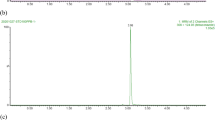Abstract
The concentration of ochratoxin A (OTA) in 120 commercial pepper (84 pre-packed and 36 bulk samples), which consist of local and imported white and black pepper in powder and seed form in Malaysia were determined. The objective of the study was to investigate and compare OTA concentration in black pepper and white pepper being commercialized in Malaysia. Determination method was based on HPLC with fluorescence detection coupled with immunoaffinity column clean-up step. Mobile phase consisted of acetonitrile–water–acetic acid (49.5:49.5:1.0, v/v/v), and flow rate was 1 ml/min. The LOD was 0.02 ng/g, and the average recovery values of OTA ranged from 79.5 to 92.0% in black pepper and 81.2–90.3% in white pepper. A total of 57 samples (47.5%) were contaminated with OTA ranging from 0.15 to 13.58 ng/g. The results showed that there was a significant difference between type of pepper and brands. OTA concentration in black pepper was significantly higher than white pepper (p < 0.05). The highest concentration of ochratoxin, 13.58 ng/g, was detected in a sample of black pepper seed followed by 12.64 ng/g in a sample of black pepper powder, both were bulk samples purchased from open market.
Similar content being viewed by others
References
Goryacheva IY, De Saeger S, Lobeau M, Eremin SA, Barna-Vetr′o I, Van Peteghem C. Approach for ochratoxin A fast screening in spices using clean-up tandem immunoassay columns with confirmation by high performance liquid chromatography—tandem mass spectrometry (HPLC–MS/MS). Anal Chimica Acta. 2006;577:38–45.
Pfohl-Leszkowicz A, Manderville RA. Review on ochratoxin A: an overview on toxicity and carcinogenicity in animals and humans. Mol Nutr Food Res. 2007;51:61–99.
Zinedine A, Brera C, Elakhdari S, Catano C, Debegnach F, Angelini S, De Santis B, Faid M, Benlemlih M, Minardi V, Miragli M. Natural occurrence of mycotoxins in cereals and spices commercialized in Morocco. Food Control. 2006;17:868–74.
IARC. IARC Monographs on the evaluation of carcinogenic risks to humans, some naturally occurring substances: food items and constituents, heterocyclic aromatic amines and mycotoxins, vol. 56, Lyon, 1993. p. 489–521.
Pfohl-Leszkowicz A. Ochratoxin A and aristolochic acid in the nephropathies and associated urothelial tract tumours development. Arh Hig Rada Toksikol. 2009;60:465–83.
Breitholtz-Emanuelson A, Olsen M, Oskarsson A, Palminger I, Hult K. Ochratoxin A in cow’s milk and in human milk with corresponding human sample blood. J Assoc Off Anal Chem. 1993;76:842–6.
Breitholtz A, Olsen M, Dahlback A, Hult K. Plasma ochratoxin A levels in three Swedish populations surveyed using an ion, pair HPLC technique. Food Addit Contam. 1991;8:183–92.
Castegnaro M, Canadas D, Vrabcheva T, Petkova-Bocharova T, Chernozemsky IN, Pfohl-Leszkowicz A. Balkan endemic nephropathy: role of ochratoxin A through biomarkers. Mol Nutr Food Res. 2006;50:519–29.
Lino C, Pena A, Silveira I, Cerejo F. Determination of ochratoxin A in Portuguese rice samples by high performance liquid chromatography with fluorescence detection. Anal Bioanal Chem. 2005;382:1288–93.
Ghali R, Hmassia-khlifa K, Ghorbel H, Maaroufi K, Hedili A. Incidence of aflatoxins, ochratoxin A and zearalenone in tunisian foods. Food Control. 2008;19:921–4.
Abdulkadar AHW, Al-Ali AA, Al-Kildi AM, Al-Jedah JH. Mycotoxins in food products available in Qatar. Food Control. 2004;15:543–8.
EC, Commission Regulation (EC) No 1881/2006 of 19 December 2006 setting maximum levels for certain contaminants in foodstuffs. Off J Eur Communities L364 2006; p. 15–17.
Food Law News (EU) FSA Update, 26 October 2006, Contaminants—October 2006 update on chemical contaminants legislation: mycotoxins p. 3–5.
MOH (Ministry of Health Malaysia), food consumption statistics in Malaysia. 2006; p. 6.
Fazekas B, Tar A, Kovacs M. Aflatoxin and ochratoxin A content of spices in Hungary. Food Addit Contam. 2005;22:856–63.
Thirunala-Devi K, Mayo MA, Reddy G, Reddy SV, Delfosse P, Reddy DVR. Production of polyclonal antibodies against ochratoxin A and its detection in chilies by ELISA. J Agric Food Chem. 2008;48:5079–82.
Castegnaro M, Tozlovanu M, Wild C, Molinié A, Sylla A, Pfohl-Leszkowicz A. Advantages and drawbacks of immunoaffinity columns in analysis of mycotoxins in food. Mol Nutr Food Res. 2006;50:480–1.
EC, Commission Regulation (EC) No 401/2006 of 23 February 2006 laying down the methods of sampling and analysis for the official control of the levels of mycotoxins in foodstuffs. Off J Eur Communities. 2006; L 70: 12–34.
Zimmerli R, Dick J. Determination of ochratoxin A at the ppt level in human blood, serum, milk and some foodstuffs by high-performance liquid chromatography with enhanced fluorescence detection and immunoaffinity column cleanup: methodology and Swiss data. J Chromatogr B. 1995;666:85–99.
Liazid A, Palma M, Brigui J, Barroso CG. Short communication investigation on ochratoxin A stability using different extraction techniques. Talanta. 2007;71:976–80.
Thirumala-Devi K, Mayo MA, Reddy G, Emmanuel KE, Larondelle Y, Reddy DVR. Occurrence of ochratoxin A in black pepper, coriander, ginger and turmeric in India. Food Addit Contam. 2001;18:830–5.
Abdulkadir EE, Tahiya AAR, Saif NAB, Charles SB. Fungi and aflatoxins associated with spices in the Sultanate of Oman. Mycopathologia. 2000;155:155–60.
Mizakova A, Pipova M, Turek Czech P. The occurrence of moulds in fermented raw meat products. J Food Sci. 2000;20:89–94.
Acknowledgments
Authors would like to acknowledge Universiti Putra Malaysia under Research University Grant scheme (RUGS) for sponsoring this research, Project No. 02/01/070024RU.
Author information
Authors and Affiliations
Corresponding author
Rights and permissions
About this article
Cite this article
Jalili, M., Jinap, S. & Radu, S. Natural Occurrence of Ochratoxin A Contamination in Commercial Black and White Pepper Products. Mycopathologia 170, 251–258 (2010). https://doi.org/10.1007/s11046-010-9320-7
Received:
Accepted:
Published:
Issue Date:
DOI: https://doi.org/10.1007/s11046-010-9320-7




